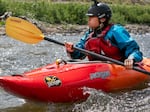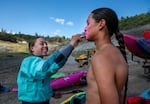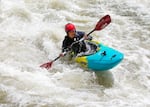
On June 22, Hoopa Valley Tribal member Julian Rogers, 16, kayaks through class 3 and 4 rapids at Kikacéki Canyon where the Copco 1 and Copco 2 dams have been removed.
Anna Lueck for OPB / OPB
A group of young Indigenous kayakers is headed to the mouth of the Klamath River in free-flowing water after portaging around two dams and paddling through four former dam sites.
They launched into the Klamath River headwaters two weeks ago and are now more than halfway through a momentous 30-day journey. So far, they’ve paddled through waves on a treacherous lake, portaged around the two remaining dams on the river, plunged into canyons with class 3, 4 and 5 rapids, and paddled through four former dam sites where removal operations wrapped up last fall.
The nonprofit Rios to Rivers organized the event, which is the first source-to-sea descent of the Klamath since dam removal. Their Paddle Tribal Waters team aims to reach the mouth of the river by July 11 and celebrate the removal of J.C. Boyle, Copco 1, Copco 2 and Iron Gate dams.
“The Klamath River source-to-sea descent is a historic opportunity to promote not only the healing of our waters, but also the healing of our people,” said Paddle Tribal Waters staff member Danielle Rey Frank, who has Hupa and Yurok ancestry.
“As we reconnect our water, we are also reconnecting our communities from up and down the basin.”
Participants in the source-to-sea descent say the 300-mile journey is about a lot more than just kayaking. The Indigenous paddlers are honoring more than a century that their ancestors spent fighting against dams on the Klamath and advocating for a healthy river.
Related: Dam removal has allowed salmon to return to the Klamath in Oregon
At the headwaters on day one, community members and tribal elders prayed and cheered on the riverbank to support the kayakers before they pushed into the water. Indigenous leaders from the headwaters to the estuary attended the launch, including Klamath Tribal Chairman William Ray Jr., Klamath tribal member Jeff Mitchell, Klamath Modoc council members, and Sue Masten and Amy Cordalis of the Yurok Tribe.
Together, they all acknowledged the hard work and dedication it took to get the dams removed. They celebrated and asked the youth to continue the path forward.
“I just want to say I’m so proud of all of you to take this journey. But learn from it, because you’re going to be the future leaders of our tribes,” Chairman Ray Jr. told the group. “I’m just filled with so much hope and joy.”
The descent began with 15 youth and about 8 staff members from Paddle Tribal Waters, with more planning to join along the way. Before they hopped into their kayaks, Mitchell sang two songs calling for their safe return home.
From there, the group settled into their kayaks and pushed into the clear blue water where Taylor Tupper and Norma Cummings from the Klamath Tribes burned sage to pray over their boats.
“We’re going to send them off in a good way,” Tupper said.
Once all of the kayakers were in the water, they gathered around for a song sung by Yurok tribal member Keeya Wiki. They formed a circle in their boats, wrapping their arms around each other’s shoulders before breaking off for what they call “the first descent.” The group paddled 7 miles that first day, mostly pushing through flat water that quickly turned from clear blue to murky brown as it flowed through agricultural fields.

Tasia Linwood, who has Karuk ancestry, kayaks the Klamath River on June 22 where the Iron Gate Dam once stood.
Anna Lueck for OPB
That night, everyone sat around a campfire reviewing the highlights of the day.
“My favorite part was seeing all the people come out for us, and telling us about their experience fighting against the dams,” said 16-year-old Hoopa tribal member Julian Rogers.
On day two, they paddled 16 miles downriver and to Agency Lake near Chiloquin. The water was mostly flat, resulting in a long day trying to get to the lake.
“I have no clue how many miles we’ve gone and how much time has passed. I’m delusional and delirious,” Rogers said while he ate a sandwich from his kayak. “But other than that it’s going pretty good.”
With no lake in sight, the group had to navigate many obstacles. The first one was a small, metal diversion dam that the group had to swiftly paddle under. After that, they faced a couple low bridges that forced them to get out and portage around.
By the time they reached the lake, many kayakers showed excitement to be almost done as they expected the remaining few miles to be quick. However, Agency Lake was full of waves so big that some paddlers compared it to an ocean, making the journey not so easy.
“That was terrible. The lake … was horrid. This is a hard birthday.” said Quartz Valley tribal member and Karuk person Ruby Williams. It was June 13, her 18th birthday, and she celebrated the rest of the afternoon after Paddle Tribal Waters staff member Cole Moore told her that was the hardest day of the whole trip.

Ruby Williams of the Quartz Valley and Karuk tribes (left), uses a zinc sunscreen stick on ‘A:de’ts-Nikya:w Rogers (right) of the Hoopa Valley Tribe on June 22 in Northern California alongside a dam deconstruction site.
Anna Lueck for OPB / OPB
After crossing Agency Lake and Upper Klamath Lake they entered the Klamath River. Then, they had to portage around Link River Dam, one of the two remaining dams on the Klamath River. Next, they picked up their kayaks and carried them around Keno Dam. Then, they got to paddle through the J.C. Boyle Dam site, where the river now runs freely.
Two days later, they approached the most anticipated rapids: Big Bend, Hell’s Corner and the Copco Dam sites. While not all of the student paddlers were cleared to kayak the class 4 and 5 rapids, a few paddled through rough white water and around rocks, demonstrating their years of training.
“To get through class 5, you’ll have to have the skills and be able to paddle some pretty hard whitewater,” said 15-year-old To’nehwan Jayden Dauz from the Hoopa Valley Tribe. He was one of the few who were cleared to kayak the heavy white water.
Dauz, Julian Rogers and his older brother ‘A:de’ts-Nikya:w Rogers were the only students to paddle Big Bend, the stretch of class 4 and 5 whitewater.

On June 22, To’nehwan Jayden Dauz from the Hoopa Valley Tribe kayaks class 3 and 4 rapids where the Copco 1 and 2 dams once stood.
Anna Lueck for OPB / OPB
The following day they reached what’s known as Hell’s Corner, a section of the river that is class 3 and 4, with three more paddlers cleared to join.
By Sunday, the group was in for a big day. They had reached the section of the river where Copco 1, Copco 2 and Iron Gate dams used to be. The first section, Kikacéki Canyon (previously known as Wards Canyon), included class 3 and 4 rapids. Most of the paddlers got through on rafts before hopping back into their kayaks for the calmer stretches of the river.
“Seeing the undammed section of river from the water was like a dream come true,” said Frank.
“I’ve spent dozens of days standing at the lookouts dreaming with our youth and community members about the day we looked down at a free-flowing river. Paddling through Iron Gate and the other reservoirs was truly living that dream.”

In this screenshot from drone footage taken on June 22, the Paddle Tribal Waters group of kayakers paddle through the Iron Gate Dam site in Northern California.
Jessie Sears / OPB
Kikacéki Canyon was previously dewatered and inaccessible because of the dams, and it has now been revitalized after the removal of Copco 1 and 2.
“It’s kind of crazy to think about,” said Tasia Linwood who has Karuk, Okanagan, Ojibwe, Wampanoag ancestry. “The first two dam sites are still there. And we had to portage around them, and I saw the dams. And now we’re going through them, and you can see on the edges where the dams were. There used to be this ginormous structure right here and I’m just going right through it. It’s really awesome.”
The group has roughly 117 miles left to go before they reach the estuary, where the river empties into the ocean in Northern California.
Sunday afternoon, Julian Rogers lounged around the campsite, with thick zinc sunscreen still on his face.
“I’m feeling burnt. I’m feeling burnt out and tired,” he said. “But I’m also feeling fulfilled because we’re officially past the dam sites, which has been amazing. I’m feeling fulfilled and ready for the rest of the river.”
